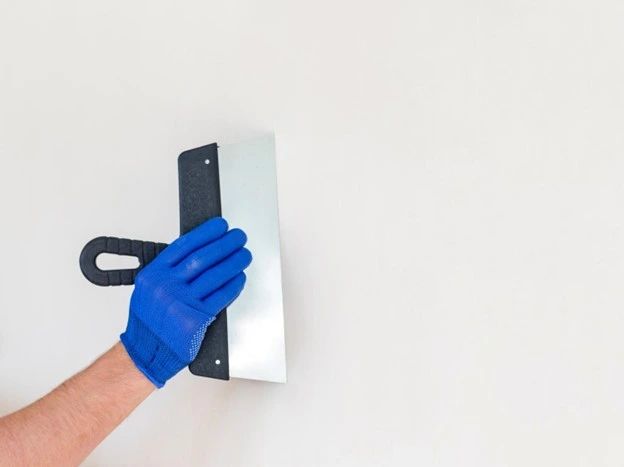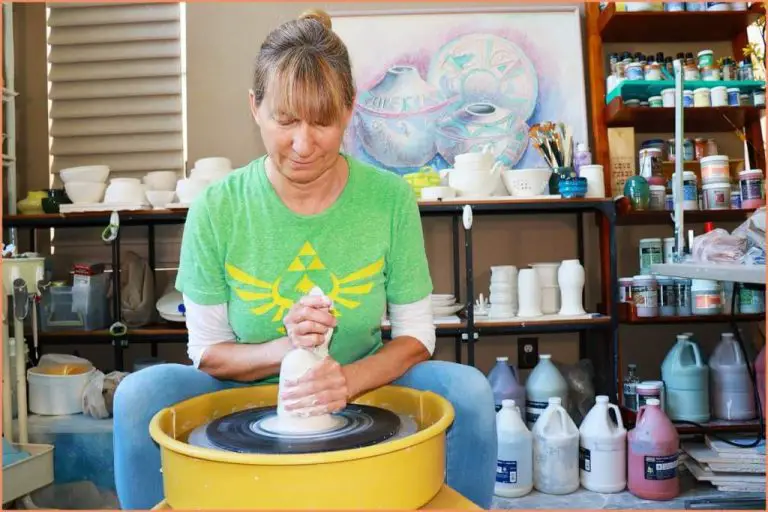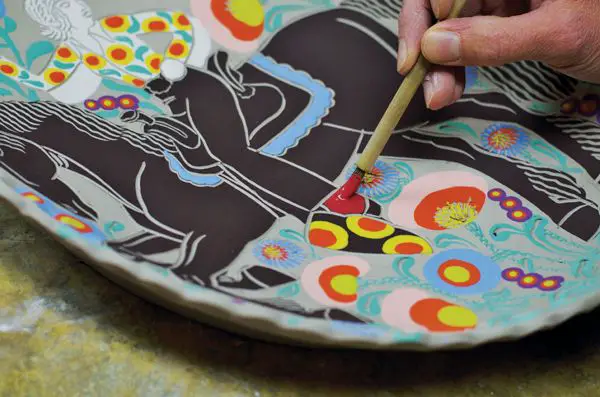Can You Mix Amaco Low Fire Glazes?
AMACO, founded in 1948, has been one of the leading ceramic and pottery manufacturers in the United States for over 70 years. They are known for producing a wide selection of low fire and high fire glazes, underglazes, clay bodies, and various tools and materials for ceramic arts (Low-fire Glaze 101 – Just the Basics). AMACO’s low fire glazes are specifically formulated to mature between cone 06 and cone 04 (1805°F-1945°F). They offer gloss, semi-gloss, satin, and matte finishes with a diverse palette of colors. AMACO low fire glazes are a popular choice for handbuilding, wheel throwing, and found object application.
Reasons to Mix Glazes
One of the biggest reasons potters and ceramic artists mix their own glazes is to achieve new colors and visual effects. By blending different glaze materials in varying ratios, infinite color possibilities open up. For example, mixing a cobalt blue glaze with an iron red glaze can produce rich purples and blacks. Adding a zirconium white to other glazes lightens the color. Using stains provides even more options for unique colors and effects like iridescence. Rather than being limited by manufactured glaze colors, mixing enables artists to create custom glazes tuned to their vision. As this article mentions, mixing glazes gives artists more control and freedom in their work.
Tips for Mixing
When mixing glazes, it’s best to start with small test batches before scaling up to larger amounts. This allows you to fine tune the recipe and avoid wasting ingredients on large batches that don’t turn out as expected. According to The Studio Manager, “Start by mixing small 10- or 25-gram test batches of the glaze before mixing up gallons of a recipe you may not like after firing” (source). Test batches let you see how a glaze looks and responds at various thicknesses and firing temperatures.
Be precise when measuring ingredients for glaze recipes. Use an accurate digital scale for dry ingredients and measuring cups for liquids. According to Ceramic Arts Network, “The key is to be as accurate and consistent as you can” (source). Carefully record the exact amounts used so you can reproduce or tweak batches in the future.
Wear a dust mask when handling dry glaze materials, as the fine particles can be harmful to inhale. Work in a well-ventilated area. Thoroughly mix dry ingredients first before adding any liquids. Use a blender for optimal incorporation of all elements. Properly stored glazes will stay fresh for future use.
Mixing Ratios
When mixing glazes, it’s important to use the proper ratios of dry glaze powder to water. Some common starting points are:
- Equal parts glaze to water (1:1 ratio): This 50/50 ratio is a good starting point for many glazes. For example, mix 100g of dry glaze with 100mL of water.
- 80% glaze powder to 20% water (4:1 ratio): Some glazes work best with less water such as 80g glaze powder to 20mL water.
- Thicker mixes like 90/10: Highly concentrated mixes with minimal water are used for special techniques like painting design layers.
It’s best to begin with the manufacturer’s recommended ratio if provided. The amount of water impacts the application thickness and drying time. Too much water will make the glaze runny and slow to dry. Too little water makes it hard to apply smoothly. Test small batches at different ratios to find the ideal consistency.
According to Seattle Pottery Supply, a starting ratio around 9:10 water to glaze works for many glazes. However, adjust as needed based on the clay body, application method, and other factors.
Using a Mixing Chart
One of the easiest ways to plan out your AMACO low fire glaze mixes is to use a glaze mixing chart. A mixing chart allows you to visualize the results of blending different ratios of glazes before mixing up test batches. This saves you time and materials since you don’t have to blindly mix glazes to find pleasing combinations.
AMACO provides a downloadable glaze mixing chart showing the results of blending their most popular glaze colors. This chart has pre-formulated combinations that the company has tested to ensure compatible chemistry and attractive results. Using this as a starting point eliminates much of the guesswork.
However, you can also create your own basic mixing chart to plan out custom combinations. Start with a grid listing your selected glaze colors across the top row and down the first column. Then for each square where two glazes intersect, note the target ratio to blend those glazes. For example, you may start with 50/50 mixes then adjust from there. A mixing chart provides a helpful blueprint before taking the time to test batches.
Layering vs. Blending
There are some key differences between layering glazes and blending glazes:
Layering involves applying multiple thin coats of glaze, one on top of the other, to build up color and effects. Each layer is allowed to dry fully before the next is applied. Layering allows for nuanced color blending and the creation of depth and dimension. According to [this source](http://www.hessers.space/blog/layering-glazing-wet-blending/).
Blending involves mixing two or more glazes together into one unified glaze before applying. The glazes blend and interact wet on the surface. Blending can create smooth gradiations of color, but does not allow the same level of depth as layering. Wet blending must be done quickly before the glazes start to dry.
In general, layering offers more control while blending creates softness. Many artists use a combination of both techniques for maximum impact.
Favorite Mixes
Some tried and true glaze mix recipes for low fire glazes that many ceramic artists enjoy include:
A popular cone 06 glaze combines 2 parts AMACO Velvet Underglaze, 1 part AMACO Wax Resist, and 1 part AMACO Low Fire Clear Glaze. This creates a smooth, creamy glaze with nice surface variation.
Mixing equal parts AMACO café and chocolate Low Fire glazes creates a rich brown glaze reminiscent of milk chocolate. Add dots of AMACO bright orange low fire glaze on top before firing for a fun, speckled effect.
Many artists enjoy mixing AMACO low fire glazes in complementary colors like blue + orange or green + red. The vibrant color combinations let the glazes interact while retaining their distinct hues.
A simple 50/50 mix of AMACO radish red and AMACO iris low fire glazes makes a classic pinkish-purple. The colors blend beautifully, with the red helping give the purple glaze extra depth.
For a metallic look, try mixing 3 parts AMACO Starry Night low fire glaze with 1 part AMACO Velvet Blue low fire glaze. The blue helps tone down the sparkle for a classy, sophisticated effect.
Avoiding Defects
When mixing glazes, it’s important to be aware of potential defects that can occur and how to avoid them. Some common glaze defects to watch out for include:
Crawling
Crawling occurs when the glaze pulls away from the edges of the ceramic piece and gathers into pools. This can be caused by underfired glazes, incompatible glazes, or applying the glaze too thick. To prevent crawling, make sure glazes are correctly mixed and fired to the proper temperature. Applying multiple thin layers can also help [1].
Crazing
Crazing refers to a network of fine cracks in the glaze surface. It’s typically caused by the glaze and clay body having mismatched expansion rates. To avoid crazing, use glaze and clay combinations that have similar expansion rates or introduce a liner glaze. Slow cooling the kiln can also help prevent crazing [2].
Blistering
Blisters or bubbles under the glaze are caused when gases get trapped during firing. Using glazes and clays with similar thermal expansion properties can help prevent blistering. Firing at the optimal temperature and allowing sufficient venting in the kiln are also important.
Testing and Documentation
Properly documenting your glaze testing is crucial for reproducing results and avoiding defects. For each test, log the exact ratios of glazes used along with observations about the fired results. According to ceramic artist Jake Johnson, “The best thing you can do is weigh out your water in grams first, then add your materials by weight in relationship to the water weight. This allows you to easily figure percentages” (source).
Some key details to record include:
- Glaze names and manufacturers
- Precise weights of each glaze component
- Firing temperature and schedule
- Observations on fired test tiles – colors, textures, defects etc.
With careful documentation, you can reliably recreate your favorite glaze mixes and learn from any failed tests. Always match glaze recipes to specific clay bodies and firing ranges for optimal results.
Conclusion
Mixing AMACO low fire glazes is a fun and creative process. With basic glazing knowledge, you can explore endless combinations to find your own signature glazes. Start with tested ratios from the manufacturer or mixing charts. Then tweak to your heart’s content with small test batches. Observe firing results closely and keep detailed notes. With practice, you’ll gain an intuitive understanding of which glaze ingredients work harmoniously together. Don’t be afraid to experiment but test thoroughly before committing your pieces to a final glaze mix. Mastering the mixing process will give you unlimited options for beautiful ceramic finishes.
The key is learning the fundamentals, taking precautions and having patience as you test. Then you can fully enjoy the thrill of exploration. Keep challenging yourself to invent new glaze recipes and combinations. After all, you never know when you might discover a mixture as unique as your creative vision.





